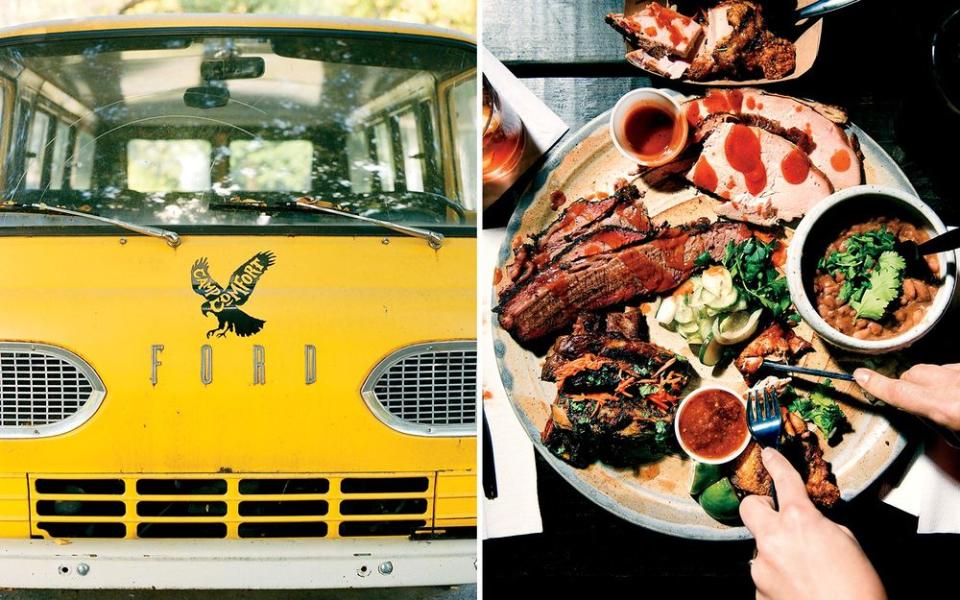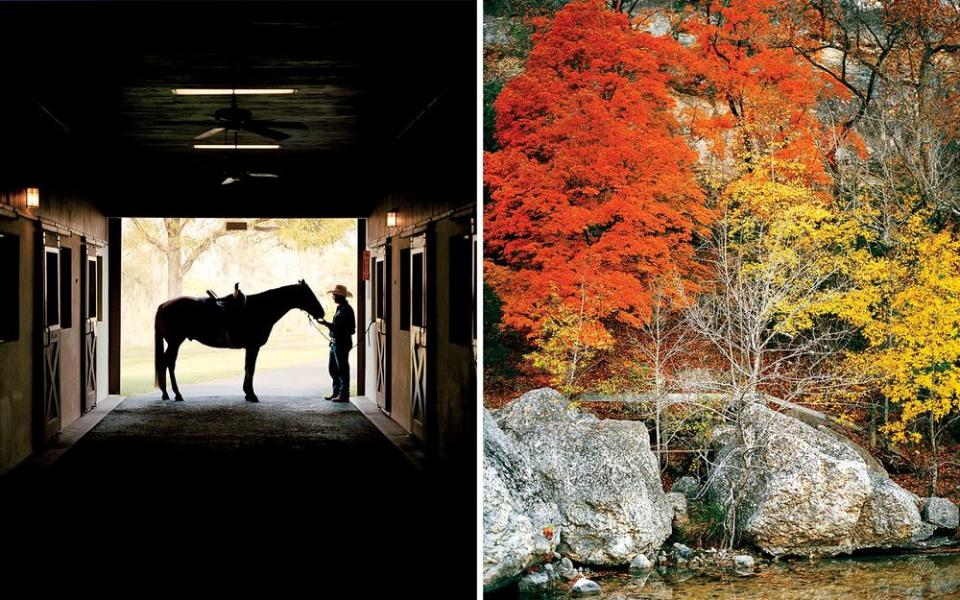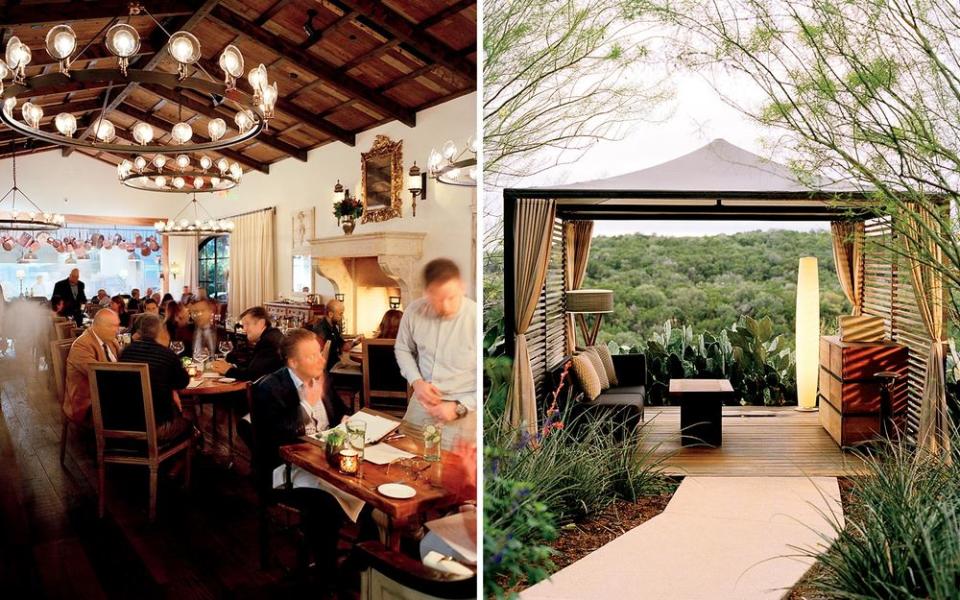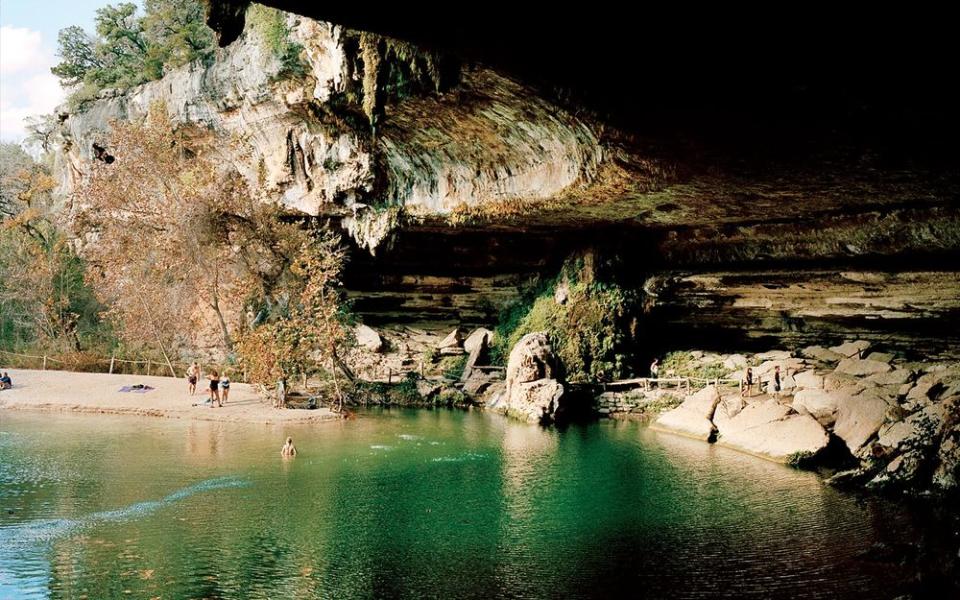How to Take a Fall Road Trip Through Texas Hill Country
Not long after arriving in Texas Hill Country, I found myself committing one of my favorite sins: eating barbecue for breakfast. I’d ducked into Keese’s Bar-B-Que in Medina — a sleepy town surrounded by apple orchards, roughly 90 minutes from San Antonio — and ordered a plate of beef brisket tacos with fresh pico de gallo. I ate it in blissful silence, observing the other diners in the small café, none of whom appeared to be in any hurry to leave. Afterward, I stepped onto Keese’s side patio to enjoy the morning sun at one of the picnic tables, whose surfaces were painted to resemble the Texas state flag, and check Google Maps for the route to Lost Maples State Natural Area. But I’d lost cell service, so I’d have to wing it.
Leaving Keese’s, I took my best guess, picked a lane, and drove out of town. The music of Robert Earl Keen (a Texas country music legend and Hill Country resident) drawled from my car’s speakers. I opened a window, remembering that breathing the warm air that hangs over these alternately lush and arid hills is its own reward. I rubbernecked to stare at what looked like antelope but turned out to be native pronghorns, grazing near vineyards along an old cattle trail around Bandera Pass.
An area covering some 11 million acres, Hill Country is bookended by San Antonio to the south and Austin to the north. This sprawling region is a wild, rural place, and its size presents considerable challenges to taking it all in. You could stuff three Connecticuts into Hill Country and still have enough space left over for Rhode Island.
Aside from its uninterrupted wilderness, Hill Country is also famous for its small towns — ike the charmingly Germanic Fredericksburg and Wimberley, a rural cradle for artists. Texan culture knits the region together. The connection is easiest to see in the Tex-Mex food and barbecue found throughout Hill Country and in the strains of music — country, blues, folk, Tejano — heard in its honky-tonks and rural dance halls.
Before long I was lost, which, while not unpleasant, was cause for embarrassment, considering that I’d visited more than a dozen times before. But I’d never been here at this time of year. I had come in pursuit not only of food, culture, and great hotels but also of autumn foliage. Yes, fall colors, in Texas: in late October and early November, weather conditions in certain pockets of the region, particularly at higher elevations and around river and creek beds, provide conditions for foliage to erupt in earthy Technicolor hues. I saw many flashes of orange and yellow and red during my drives, though I quickly learned that predicting the time and place where colors bloom, the subject of leaf-hunting Facebook pages and blogs, is an inexact science.
Though the name Hill Country doesn’t promise the drama of a mountain range, the high views over expansive valleys are breathtaking. Leakey, one of the towns I passed through after losing my way, is known locally as the Swiss Alps of Texas. The clearest views are of infinite landscapes that undulate until they’re swallowed by the horizon. Was this Provence without the castles? I wondered. The Pyrenees with lower peaks and taller hats?
Related: 14 Fall Road Trips for Seeing the Best Fall Foliage — and a Whole Lot More
In addition to its hills, Hill Country is a mash-up of stone-strewn plains, limestone cliffs, dew-wet forests, and sun-scorched rangeland. Repeatedly, I experienced the vertigo of roads that felt like vertical switchbacks. They crested amid noticeably cooler air, then plunged into valleys marked by giant roadside rulers that measure the depths of the frequent and often dangerous flash floods.
When cell service kicked in again, I frantically looked up directions to Lost Maples State Natural Area. Miraculously, I wasn’t too far away. The park, which is 90 miles northwest of San Antonio and covers more than 2,000 acres, has a spacious welcome station with a chalkboard list of “birds to look for.” It ran to 88 species, from Acadian flycatchers to yellow-rumped warblers. On my late morning hike, I traversed jagged limestone bedrock and half-dry riverbeds, with enough variations in temperature that I drove away with one sunburned arm and a frozen toe, thanks to a slip into cold creek water.
Hill Country destinations like Marble Falls and Fredericksburg see traffic spike in April, when the bluebonnets and other wildflowers are in full bloom, but at Lost Maples, autumn is high season. I heeded warnings to arrive before noon to avoid the crowds and was rewarded with near solitude on the trails. A ranger wearing silver maple-leaf earrings described the conditions as “mid color.” That meant bursts of rust and red edged with deep yellow, flaming orange, and pale green. The blend of maples, oaks, sumacs, and sycamores were all the more vivid against the marbled-gray backdrop of a canyon wall.
Robert Caro, the Lyndon Baines Johnson biographer who has spent decades chronicling the life of the Hill Country native, once said that the moment he realized his subject “was going to be really hard for me to understand was the first time I drove out of Austin into the Hill Country.” The native New Yorker was talking about how far removed Hill Country was, and often still feels, from city life. I’ve never gotten used to the swiftness with which the subdivisions are supplanted by lonely windmills and white-tailed deer.
I spent the first night of my trip in one of the tin-roofed cabins on the grounds of Camp Comfort, in the town of Comfort, roughly an hour from San Antonio. Opened in 2014, Camp Comfort calls itself a bed-and-breakfast, but it is really a fashionable, budget-friendly rural retreat, on the site of a 19th-century social club that became a bowling alley in the early 20th century. There’s an indoor common area where the lanes once were, as well as an outside stage, where the camp often hosts local singer-songwriters. The cabins are built largely of reclaimed wood.

The evening I arrived, children were trick-or-treating on the street leading up to the camp. The leaves of the riverbank cypresses were beginning to yellow. When night fell, I sipped wine in an Adirondack chair with my feet at the edge of a roaring fire. It took a bit for my eyes and ears to recalibrate. While daytime in Hill Country is staggeringly bright—the sun hammers down from big skies — the night gets pitch dark. By 8 p.m. the sky was an inky blue, and the temperature had dropped at least 20 degrees.
From Camp Comfort, I drove to the Inn at Dos Brisas, a Relais & Châteaux property in the town of Washington. Dos Brisas lies just beyond Hill Country’s eastern edge, but it still captures the spirit of the region, and the rolling, forested grounds are as much a draw as the luxury accommodations. There were few signs of autumn, but near a creek I found a particularly gorgeous example of orange-blushing sycamore.
Dos Brisas is uniquely Texan, with the air of a wealthy person’s ranch. It is beloved by the well-heeled Houston crowd, who come for the huge indoor riding arena. (It’s common to spy guests on horseback, outfitted as though for a Ralph Lauren ad.) In terms of guest quarters, however, the footprint is small: there are only nine haciendas and casitas, albeit large ones, tastefully decorated with Persian carpets and leather furniture.

Another reason people come to Dos Brisas is for the food. It has a 42-acre farm and a 7,000-square-foot greenhouse, both of which fuel a standout culinary program led by executive chef Zachary Ladwig, who trained at Bouley in New York. You can eat meals in your hacienda, although I took mine in the main restaurant, inside what is literally a mansion on a hill.
On my first night, the Houston Astros moved one game closer to winning the World Series, animating a dining room that was populated by preppy Texas couples sharing bottles of Meursault. I ate a partially boned, boudin-stuffed, Texas shrubland quail, accompanied by Dos Brisas produce — cannelloni-bean ragoût, grilled scallions, pink radishes — that deepened the Texas accent of Ladwig’s fine cuisine.
On my second day, I wandered the grounds, mainly from the seat of an electric golf cart, steering past organic gardens and a clay-shooting range. I took a garden tour with Ladwig, who showed me broccoli, cabbage, cauliflower, and kale all ready to harvest — another benefit of a fall visit. He became particularly animated where the chickens ranged freely near beds of snapdragons and nasturtiums, whose flowers are edible, explaining how the gardens compel his cooking in a “vegetable forward” direction — a refreshing twist in Texas, where the cattle-ranching mystique still holds sway.
That night, I slathered butter, enriched with chicken skin, over hot buttermilk biscuits. A fried, panko-crusted egg rested on a bed of fresh salsify, baby squash, and edible flowers. “Having a chef who works with you is crucial,” said Steve King, the general manager of Dos Brisas Farms, who was wearing a sweat-stained, wide-brimmed leather hat. A plant-breeding Ph.D., he helps Ladwig write menus inspired by seasonal crops. “The farm exists for the restaurant,” King added.
On my way out of Washington I passed through Brenham to visit Truth Barbeque, one of a new generation of small, artisanal smoked-meat joints that have made national headlines. Truth is open only Friday to Sunday, and the lines are long, so I ordered as if it were a once-in-a-lifetime opportunity to sample the celebrated brisket and pulled-to-order smoked pork. It was enough to sate me for the drive ahead, which I routed through the Hill Country town of Blanco. It is cut through by the Blanco River, and for stretches the road follows its limestone banks. I found myself repeatedly surrounded by fields of little bluestem, a perennial bunchgrass that turns russet red in the fall, even in areas where trees remained green.
Hill Country’s parks, historic towns, and casual restaurants make it ideal for a family getaway. So now, midway through my trip, I was on my way to meet my wife and two sons, ages one and three, at the slightly lower-key La Cantera Resort & Spa, a Destination Hotel, near San Antonio. The resort is positioned on one of the highest points in the area, and its proportions are characteristically Texan, which is to say it’s big: nearly 500 rooms, nine restaurants and bars, two golf courses, and five swimming pools spread over 550 acres. The views are of a lush, rolling expanse where Hill Country peacefully coexists with the San Antonio suburbs. The four of us decided to take advantage of the family-friendly amenities, and in the space of an afternoon, La Cantera converted me from a waterslide virgin to a full-throated evangelist.

La Cantera is also the site of Signature, the newest restaurant from chef Andrew Weissman, who built his reputation at San Antonio’s Le Rêve in the early 2000s. Though it closed in 2009, I agreed with the consensus at the time that Le Rêve was among the most accomplished French restaurants between the coasts.
Weissman told me his food “twists what I grew up eating in San Antonio” with Texas ingredients and French technique. Our meal included raw oysters garnished with pickled peppers; supple, house-made pappardelle; and Hill Country venison draped in green-peppercorn sauce. One of Weissman’s favorite desserts is a cardamom paleta, his take on the Latin American ice pops found all over San Antonio.
The antiques-strewn restaurant occupies a window-filled building a short walk down the hill from La Cantera’s villas. At night, it appears to glow from an underground source of golden light. There, you can forget you’re so close to the city, particularly if you get a table with a view. “If you look out the windows at certain angles,” Weissman said, “it looks like you could be in the foothills of Hill Country, or you could be in Italy — those verdant, rolling hills.”
There was a time when Weissman, who honed his chops in France, was a rare bird in this part of Texas. Today, it’s possible to find the kinds of pleasures he offers — modern, satisfying alternatives to Tex-Mex and barbecue — even in Hill Country’s rural small towns.
Fredericksburg, an hour north of La Cantera, is among the area’s best-known destinations. Its bakeries, beer gardens, and gift shops still bear the imprint of 19th-century German settlers, but it’s also the site of Hill Country’s burgeoning cosmopolitanism. The warm, sunny climate here has proven ideal for growing Cabernet Sauvignon, among other grapes. Now Fredericksburg and its environs are home to tasting rooms from up-and-coming wineries like 4.0 Cellars, William Chris Vineyards, and Pedernales Cellars. Restaurants like Vaudeville, a home-furnishings store and café in the center of town, serve wood-fired pizzas, gourmet sandwiches, and more ambitious, globally influenced entrées at night.
But I knew my kids’ new favorite place would be the Hamilton Pool Preserve. The park, about an hour east of Fredericksburg (and just under two hours northeast of La Cantera) is 232 acres of protected land with a natural, jade-green pool at the center of it. My three-year-old collected fallen leaves on the hike down to the secluded swimming hole. We waded into the cold water, a small, exposed section of an underground river, and stood under the gently trickling waterfalls at the back end of the pool. It was like swimming in a cave that contains both forest and blue sky.

We spent the rest of the day touring areas around Hamilton Pool, where Hill Country bears the strong influence of nearby Austin. Jester King Brewery, on the outskirts of the city near Dripping Springs, makes what my friend Matthew Odam, the Austin American-Statesman’s restaurant critic, insists is the best beer in central Texas. We went on Matthew’s recommendation, just after our Saturday swim, to find the brewery’s grounds had been transformed into a pastoral celebration of Texas’s artisanal boom. There were long picnic tables overflowing with people tearing apart pizzas cooked in a horse trailer that had been converted into a wood-burning oven. I bought a bottle of Swedish-style ale brewed with juniper at a table outside the tasting room, near where a banjo-fiddle duo played.
Related: This Natural Pool Is the Best-kept Secret in Texas
From there we made the short drive to Treaty Oak Distilling, where the scene was equally memorable. The operation, like Jester King’s, was set up to show off both Hill Country’s great outdoors and the wares of a burgeoning class of entrepreneurial brewers and distillers. Lines formed in front of the taps inside a metal-sided barn, some containing Treaty Oak’s beers, others dispensing cocktails made with its rum, bourbon, and gin. Another building holds Ghost Hill Restaurant, one of a slew of new spots expanding the borders of traditional Texas barbecue with dishes like cumin-cilantro hummus, lemon-garlic vegetables, and Asian-style spare ribs in addition to classic smoked brisket.
Most of Treaty Oak’s 30 acres are undeveloped rolling grassland. We took our lunch of hummus, green-chile pimento cheese, brisket, and pulled pork to a table beneath one of the many oak trees. The leaves were still green. Later, we took a walk and saw, in the distance, patches of orange and golden yellow, signs of the seasonal change that inevitably comes, even here.
Exploring Texas Hill country
Plan on spending several days in this central Texas region of farmland and prairies, road-tripping to barbecue spots and wandering historic towns like Fredericksburg. And if you time your visit for early November, you can take in the colorful fall foliage. Choose whichever route or itinerary you wish — there’s no one way to experience Hill Country. Just remember to go slow.
Getting There
The best way to navigate Hill Country and its nearly 11 million acres is by car. Rent one after flying in to San Antonio or Austin, the cities that serve as gateways to the region.
Lodging
There are a few top-notch resorts in the area, including La Cantera Resort & Spa, a Destination Hotel (doubles from $209), near San Antonio. With its five pools, nine restaurants and bars, and decidedly laid-back atmosphere, it is ideal for families: parents should look into Babierge, a service through which they can rent cribs, toys, and children’s books. It also has a great restaurant for date night: Signature, run by Andrew Weissman.
The Inn at Dos Brisas (casitas from $490), in Washington, is east of Austin and beyond Hill Country’s border, but it is arguably Texas’s top hotel—and very much worth a visit if you are in the area. It has a sprawling equestrian center, a 7,000-bottle wine cellar, and organic gardens that supply the fantastic on-site restaurant, which has a vegetable-heavy menu (a salad of 15 lettuces with herbs and flowers; peekytoe crab wrapped in kale).
I also love Camp Comfort (doubles from $205), a collection of warm, renovated cabins high above Cypress Creek in the town of Comfort, one hour northwest of San Antonio. The friendly owners, Phil and Lisa Jenkins, are extremely hands-on and a great resource.
Glamping has come to this corner of Texas, and fall is a great time to try new properties such as Walden Retreats (tents from $300), which has luxury tents on 96 acres outside Johnson City, right in the middle of Hill Country. And Collective Retreats (tents from $500), a young brand with properties in places like New York’s Hudson Valley, opened last fall near Wimberley. The beautiful tents have en suite bathrooms and wood-burning stoves, which come in handy on cool fall nights; on-site activities include fly-fishing and ziplining.
Eat & Drink
Texas barbecue is legendary — and two of my favorites places for it are Keese’s Bar-B-Que (13869 TX-16; 830-589-7474), in the town of Medina (don’t miss the beef brisket), and Truth Barbeque, in Brenham, voted one of the state’s best by the editors of Texas Monthly. In Fredericksburg, Otto’s (entrées $20–$52) nods to the town’s German past with standout duck schnitzel and house-made sausages. Vaudeville (entrées $16–$38), a home-design showroom with a bistro, reflects the sophisticated present thanks to dishes such as charred octopus and burrata with truffled asparagus.
The craft-beer scene is also booming. At Jester King Brewery, on the outskirts of Austin, you can listen to live music while sipping barrel-aged beers fermented a second time with strawberries. About a 10-minute drive west, Treaty Oak Distilling is a massive facility set on 30 acres that produces its own gin, rum, and bourbon. Order some ribs at Ghost Hill Restaurant, located on the grounds.
Activities
Though Lost Maples State Natural Area, in Vanderpool, is about a 90-mile drive northwest of San Antonio, there is no better place to experience Hill Country’s fall colors. If you’re traveling with kids, Hamilton Pool Preserve, in the town of Dripping Springs, about a 30-mile drive west of Austin, is a must. This forested park has a beautiful natural swimming hole; online reservations are required.

